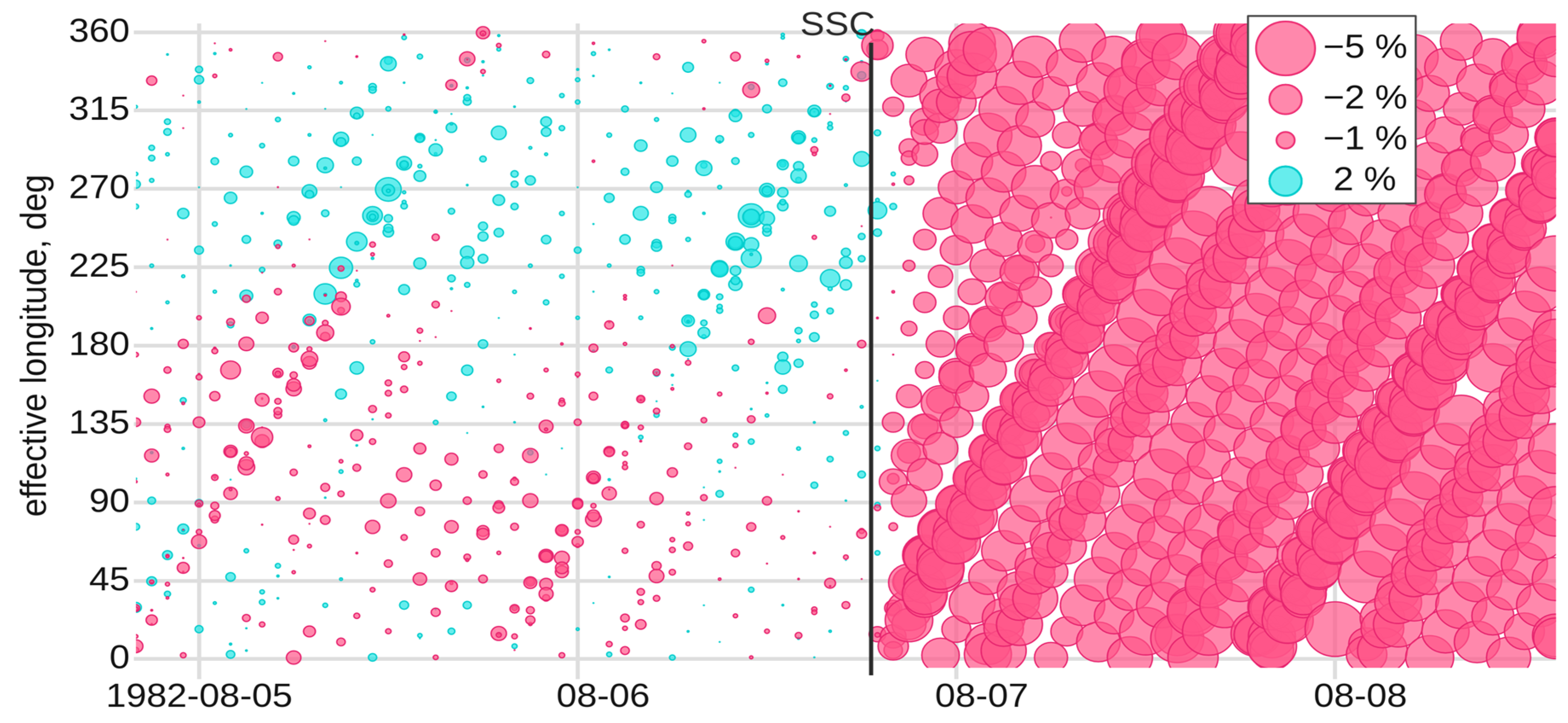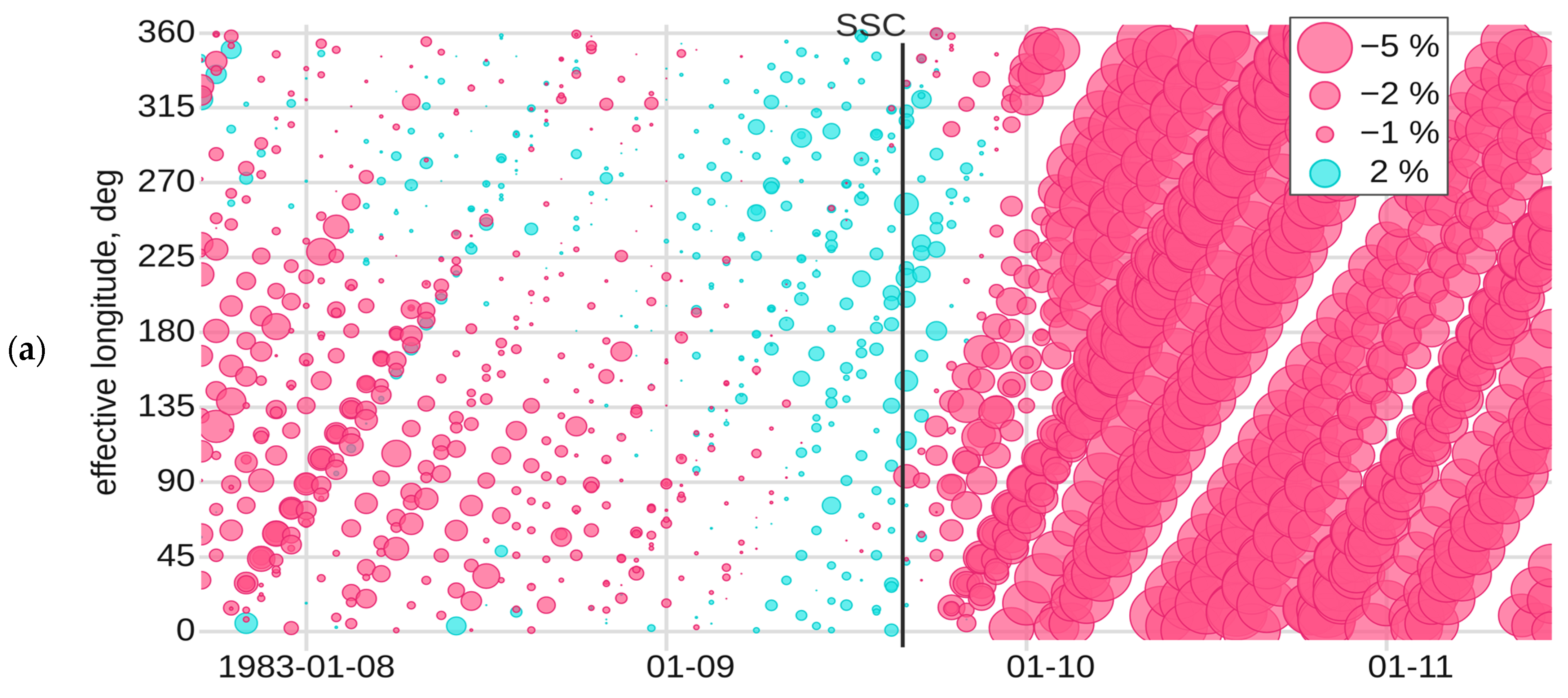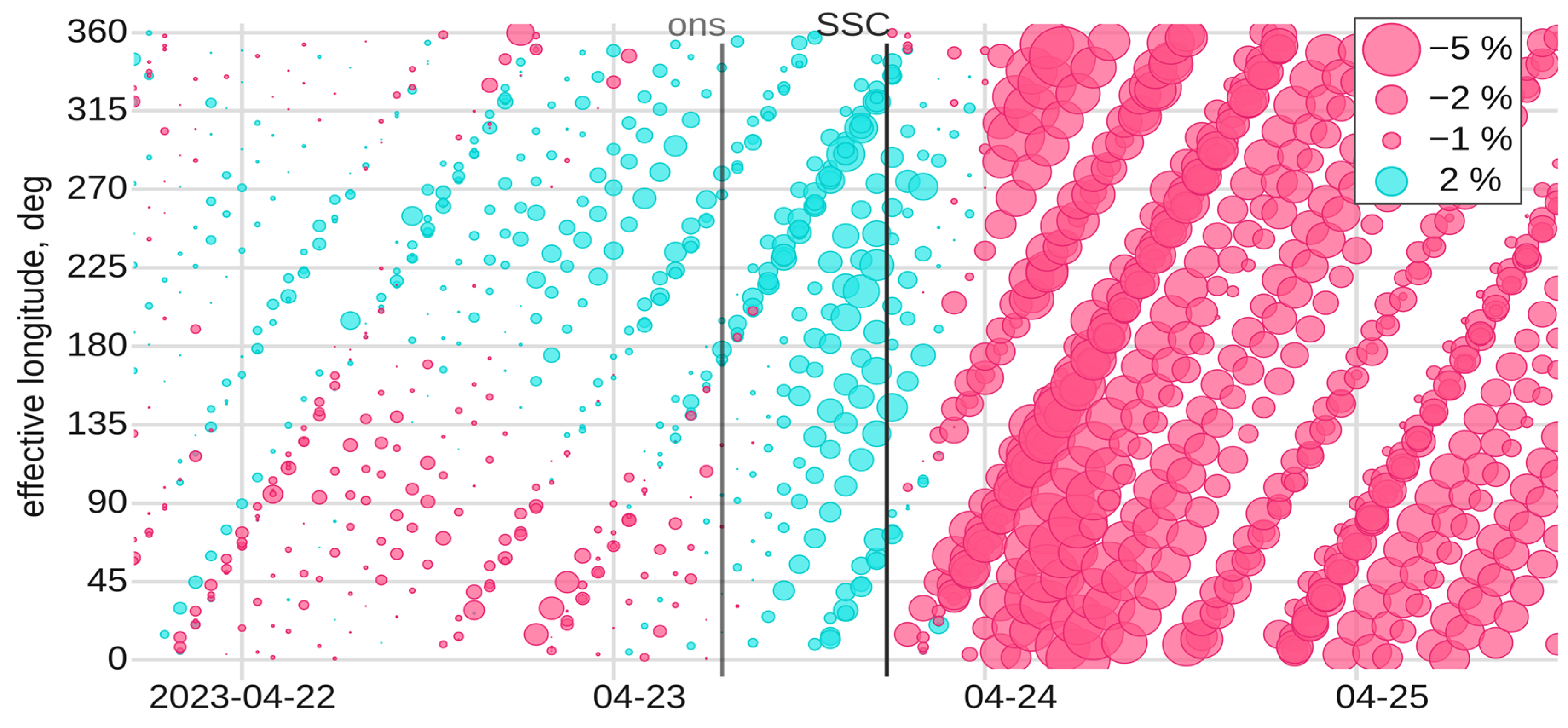Precursory Signs of Large Forbush Decreases in Relation to Cosmic Rays Equatorial Anisotropy Variation
Abstract
:1. Introduction
2. Data and Method
3. Results
4. Conclusions and Discussion
Author Contributions
Funding
Institutional Review Board Statement
Informed Consent Statement
Data Availability Statement
Acknowledgments
Conflicts of Interest
References
- Grieder, P.K.F. Cosmic Rays at Earth; Elsevier: Amsterdam, The Netherlands, 2001. [Google Scholar]
- Vainio, R.; Desorgher, L.; Heynderickx, D.; Storini, M.; Flückiger, E.; Horne, R.B.; Kovaltsov, G.A.; Kudela, K.; Laurenza, M.; McKenna-Lawlor, S.; et al. Dynamics of the Earth’s particle radiation environment. Space Sci. Rev. 2009, 147, 187–231. [Google Scholar] [CrossRef]
- Drury, L.O. Origin of cosmic rays. Astropart. Phys. 2012, 39–40, 52–60. [Google Scholar] [CrossRef]
- Mironova, I.A.; Aplin, K.L.; Arnold, F.; Bazilevskaya, G.A.; Harrison, R.G.; Krivolutsky, A.A.; Nicoll, K.A.; Rozanov, E.V.; Turunen, E.; Usoskin, I.G. Energetic Particle Influence on the Earth’s Atmosphere. Space Sci. Rev. 2015, 194, 1–96. [Google Scholar] [CrossRef]
- Baker, D.N. What is Space Weather. Adv. Space Res. 1998, 22, 7–16. [Google Scholar] [CrossRef]
- Masarik, J.; Beer, J. Simulation of particle fluxes and cosmogenic nuclide production in the Earth’s atmosphere. J. Geophys. Res. 1999, 104, 12099–12111. [Google Scholar] [CrossRef]
- Daglis, I.A. Effects of Space Weather on Technology Infrastructure; NATO ASI Series; Wiley: Hoboken, NJ, USA, 2004. [Google Scholar]
- Singh, A.K.; Singh, D.; Singh, R.P. Impact of galactic cosmic rays on Earth’s atmosphere and human health. Atmos. Environ. 2011, 45, 3806–3818. [Google Scholar] [CrossRef]
- Li, W.-H.; DAMPE Collaboration. A study of Forbush Decreases effects with DAMPE experiment. In Proceedings of the 38th International Cosmic Ray Conference (ICRC2023), Nagoya, Japan, 26 July–3 August 2023; p. 1311. [Google Scholar] [CrossRef]
- Daglis, I.A. Space Storms and Space Weather Hazards; NATO ASI Series; Wiley: Hoboken, NJ, USA, 2001. [Google Scholar]
- Miroshnichenko, L. Solar Cosmic Rays; Kluwer Academic Press: Norwell, MA, USA, 2001. [Google Scholar]
- Miroshnichenko, L.I. Solar cosmic rays in the system of solar–terrestrial relations. J. Atmos. Sol. Terr. Phys. 2008, 70, 450–466. [Google Scholar] [CrossRef]
- Anastasiadis, A.; Lario, D.; Papaioannou, A.; Kouloumvakos, A.; Vourlidas, A. Solar energetic particles in the inner heliosphere: Status and open questions. Phil. Trans. R. Soc. 2019, A377, 20180100. [Google Scholar] [CrossRef] [PubMed]
- Bazilevskaya, G.A. Once again about origin of the solar cosmic rays. J. Phys. Conf. Ser. 2017, 798, 012034. [Google Scholar] [CrossRef]
- Forbush, S.E. On the Effects in the Cosmic-Ray Intensity Observed During the Recent Magnetic Storm. Phys. Rev. 1937, 51, 1108–1109. [Google Scholar] [CrossRef]
- Forbush, S.E. On the World-Wide Changes in Cosmic-Ray Intensity. Phys. Rev. 1938, 54, 975. [Google Scholar] [CrossRef]
- Hess, V.F.; Demmelmair, A. World-wide Effect in Cosmic Ray Intensity, as Observed during a Recent Magnetic Storm. Nature 1937, 140, 316. [Google Scholar] [CrossRef]
- Kane, R.P. Severe geomagnetic storms and Forbush decreases: Interplanetary relationships re-examined. Ann. Geophys. 2010, 28, 479–489. [Google Scholar] [CrossRef]
- Lockwood, J.A. Forbush decreases in the cosmic radiation. Space Sci. Rev. 1971, 12, 658–715. [Google Scholar] [CrossRef]
- Singer, S.F. Storm decrease of the cosmic radiation at the pole. Phys. Rev. 1954, 95, 647. [Google Scholar]
- Singer, S.F. Observations of Cosmic Ray Decreases at the Pole. Nuovo C. 1958, 8, 326–333. [Google Scholar] [CrossRef]
- Simpson, J.A. Neutrons Produced in the Atmosphere by the Cosmic Radiations. Phys. Rev. 1951, 83, 1175–1188. [Google Scholar] [CrossRef]
- Simpson, J.A. Cosmic-Radiation Intensity-Time Variations and Their Origin. III The Origin of 27-Day Variations. Phys. Rev. 1954, 94, 426–440. [Google Scholar] [CrossRef]
- Simpson, J.A.; Fonger, W.; Treiman, S. Cosmic Radiation Intensity-Time Variations and Their Origin. I. Neutron Intensity Variation Method and Meteorological Factors. Phys. Rev. 1953, 90, 934–950. [Google Scholar] [CrossRef]
- Cane, H.V. Coronal mass ejections and Forbush decreases. Space Sci. Rev. 2000, 93, 55–77. [Google Scholar] [CrossRef]
- Qin, G.; Wu, S.-S. Magnetic Cloud and Sheath in the Ground-level Enhancement Event of 2000 July 14. II. Effects on the Forbush Decrease. Astrophys. J. 2021, 908, 236. [Google Scholar] [CrossRef]
- Cane, H.V.; Richardson, I.G.; Wibberenz, G. The Response of Energetic Particles to the Presence of Ejecta Material. Int. Cosm. Ray Conf. 1995, 4, 377. [Google Scholar]
- Baral, R.; Adhikari, B.; Calabia, A.; Shah, M.; Mishra, R.K.; Silwal, A.; Bohara, S.; Manandhar, R.; del Peral, L.; Frías, M.D.R. Spectral Features of Forbush Decreases during Geomagnetic Storms. J. Atmos. Sol. Terr. Phys. 2023, 242, 10598. [Google Scholar] [CrossRef]
- Dorman, L.I. Cosmic Ray Variations and Space Research; Nauka: Moscow, Russia, 1963; p. 1027. [Google Scholar]
- Belov, A.V. Forbush Effects and Their Connection with Solar, Interplanetary and Geomagnetic Phenomena; Gopalswamy, N., Webb, D.F., Eds.; Proceedings of the International Astronomical Union, IAU Symposium S257: Universal Heliophysical Processes; Cambridge University Press: Cambridge, UK, 2008; pp. 439–450. [Google Scholar] [CrossRef]
- Richardson, I.G. Energetic Particles and Corotating Interaction Regions in the Solar Wind. Space Sci. Rev. 2004, 111, 267. [Google Scholar] [CrossRef]
- Richardson, I.G. Solar wind stream interaction regions throughout the heliosphere. Living Rev. Sol. Phys. 2018, 15, 1. [Google Scholar] [CrossRef] [PubMed]
- Dumbovic, M.; Vrsnak, B.; Calogovic, J.; Karlica, M. Cosmic ray modulation by solar wind disturbances. Astron. Astrophys. 2011, 531, A91. [Google Scholar] [CrossRef]
- Dumbovic, M.; Vrsnak, B.; Calogovic, J.; Zupan, R. Cosmic ray modulation by different types of solar wind disturbances. Astron. Astrophys. 2012, 538, A28. [Google Scholar] [CrossRef]
- Wawrzynczak, A.; Alania, M. Modeling and data analysis of a Forbush decrease. Adv. Space Res. 2010, 45, 622–631. [Google Scholar] [CrossRef]
- Arunbabu, K.P.; Antia, H.M.; Dugad, S.R.; Gupta, S.K.; Hayashi, Y.; Kawakami, S.; Mohanty, P.K.; Oshima, A.; Subramanian, P. How are Forbush decreases related to interplanetary magnetic field enhancements? Astron. Astrophys. 2015, 580, A41. [Google Scholar] [CrossRef]
- Zhao, L.L.; Zhang, H. Transient Galactic Cosmic-Ray Modulation During Solar Cycle 24: A Comparative Study of Two Prominent Forbush Decrease Events. Astrophys. J. 2016, 827, 13. [Google Scholar] [CrossRef]
- Dumbović, M.; Kramarić, L.; Benko, I.; Heber, B.; Vršnak, B. A new method of measuring Forbush decreases. arXiv 2024, arXiv:2401.09000. [Google Scholar] [CrossRef]
- Blokh, Y.L.; Dorman, L.I.; Kaminer, N.S. Proceedings of the Moscow Cosmic Ray Conference, July 6–11, 1959; International Conference of Cosmic Radiation: Moscow, Russia, 1960. [Google Scholar]
- Fenton, A.G.; McCracken, K.G.; Rose, D.C.; Wilson, B.G. The onset times of Forbush-type cosmic ray intensity decreases. Can. J. Phys. 1959, 37, 970–982. [Google Scholar] [CrossRef]
- Nagashima, K.; Sakakibara, S.; Fujimoto, K.; Fujji, Z.; Ueno, H. Local-time- dependent precursory decrease of cosmic rays, in front of Forbush-decrease-associated IMF shock wave, observed on September 9, 1992. In Proceedings of the 23rd ICRC, Calgary, AB, Canada, 19–30 July 1993; Volume 3, pp. 711–714. [Google Scholar]
- Leerungnavarat, K.; Ruffolo, D.; Bieber, J.W. Loss cone precursors to Forbush decreases and advance warning of space weather effects. Astrophys. J. 2003, 593, 587–596. [Google Scholar] [CrossRef]
- Munakata, K.; Kuwabara, T.; Yasue, S.; Kato, C.; Akahane, S.; Koyama, M.; Ohashi, Y.; Okada, A.; Aoki, T.; Mitsui, K.; et al. A “Loss-Cone” Precursor of an Approaching Shock Observed by a Cosmic-Ray Muon Hodoscope on October 28, 2003. Geophys. Res. Lett. 2005, 32, L03S04. [Google Scholar] [CrossRef]
- Fushishita, A.; Kuwabara, T.; Kato, C.; Yasue, S.; Bieber, J.W.; Evenson, P.; Da Silva, M.R.; Dal Lago, A.; Schuch, N.J.; Tokumaru, M.; et al. Precursors of the Forbush Decrease on 2006 December 14 Observed with the Global Muon Detector Network (GMDN). Astrophys. J. 2010, 715, 1239–1247. [Google Scholar] [CrossRef]
- Dorman, L.I. Space weather and dangerous phenomena on the Earth: Principles of great geomagnetic storms forcasting by online cosmic ray data. Ann. Geophys. 2005, 23, 2997–3002. [Google Scholar] [CrossRef]
- Badruddin. Transient perturbations and their effects in the heliosphere, the geo-magnetosphere, and the Earth’s atmosphere: Space weather perspective. J. Astrophys. Astron. 2006, 27, 209–2017. [Google Scholar] [CrossRef]
- Pulkkinen, T. Space Weather: Terrestrial Perspective. Living Rev. Sol. Phys. 2007, 4, 1. Available online: http://www.livingreviews.org/lrsp-2007-1 (accessed on 12 May 2024). [CrossRef]
- Badruddin, B.; Aslam, O.P.M.; Derouich, M.; Asiri, H.; Kudela, K. Forbush decreases and geomagnetic storms during a highly disturbed solar and interplanetary period, 4–10 September 2017. Space Weather 2019, 17, 487–496. [Google Scholar] [CrossRef]
- Ruffolo, D.; Bieber, J.W.; Evenson, P.; Pyle, R. Precursors to Forbush decreases and space weather prediction. In Proceedings of the 26th International Cosmic-Ray Conference, Salt Lake City, UT, USA, 17–25 August 1999; Kieda, D., Salamon, M., Dingus, B., Eds.; International Union of Pure and Applied Physics: Salt Lake City, UT, USA, 1999; Volume 6, pp. 440–443. [Google Scholar]
- Abunina, M.A.; Belov, A.V.; Eroshenko, E.A.; Abunin, A.A.; Yanke, V.G.; Melkumyan, A.A.; Shlyk, N.S.; Pryamushkina, I. Ring of Stations Method in Cosmic Rays Variations Research. Sol. Phys. 2020, 295, 69. [Google Scholar] [CrossRef]
- Dorman, L.I.; Iucci, N.; Villoresi, G. The nature of cosmic ray Forbush decrease and precursory effects. In Proceedings of the 24th International Cosmic-Ray Conference, Rome, Italy, 28 August–8 September 1995; Iucci, N., Lamanna, E., Eds.; International Union of Pure and Applied Physics: Rome, Italy, 1995; Volume 4, pp. 892–895. [Google Scholar]
- Kudela, K.; Storini, M. Possible tools for space weather issues from cosmic ray continuous records. Adv. Space Res. 2006, 37, 1443–1449. [Google Scholar] [CrossRef]
- Bieber, J.W.; Evenson, P. Spaceship Earth—An optimized network of neutron monitors. In Proceedings of the 24th International Cosmic Ray Conference, Rome, Italy, 28 August–8 September 1995; Volume 4, pp. 1316–1319. [Google Scholar]
- Asipenka, A.; Belov, A.V.; Eroshenko, E.; Mavromichalaki, H.; Papailiou, M.; Papaioannou, A.; Oleneva, V.; Yanke, V.G. Asymptotic longitudinal distribution of cosmic ray variations in real time as the method of interplanetary space diagnostic. In Proceedings of the 31st International Cosmic Ray Conference, Lodz, Poland, 7–15 July 2009; Available online: http://cosray.phys.uoa.gr/index.php/publications-menu/publications (accessed on 12 May 2024).
- Munakata, K.; Bieber, J.W.; Yasue, S.; Kato, C.; Koyama, M.; Akahane, S.; Fujimoto, K.; Fujii, Z.; Humble, J.E.; Duldig, M.L. Precursors of geomagnetic storms observed by muon detector network. J. Geophys. Res. 2000, 105, 27457–27468. [Google Scholar] [CrossRef]
- Munakata, K.; Yasue, S.; Kato, C.; Kota, J.; Tokumaru, M.; Kojima, M.; Darwish, A.A.; Kuwabara, T.; Bieber, J.W. On the cross-field diffusion of galactic cosmic rays into an ICME, WSPC/SPI-B368. Adv. Geosci. 2006, 2, 115–124. [Google Scholar]
- Belov, A.V.; Bieber, J.W.; Eroshenko, E.A.; Evenson, P.; Pyle, R.; Yanke, V.G. Pitch-angle features in cosmic rays in advance of severe magnetic storms: Neutron monitor observations. In Proceedings of the 27th International Cosmic Ray Conference (ICRC 2001), Hamburg, Germany, 7–15 August 2001; Droege, W., Kunow, H., Scholer, M., Eds.; International Union of Pure and Applied Physics: Hamburg, Germany, 2001; Volume 9, pp. 3507–3510. [Google Scholar]
- Gosling, J.T.; Bame, S.J.; McComas, D.J.; Phillips, J.L. Coronal mass ejections and large geomagnetic storms. Geophys. Res. Lett. 1990, 17, 901. [Google Scholar] [CrossRef]
- Richardson, I.G.; Cane, H.V. Solar wind drivers of geomagnetic storms during more than four solar cycles. J. Space Weather Space Clim. 2012, 2, A01. [Google Scholar] [CrossRef]
- Calisto, M.; Usoskin, I.; Rozanov, E.; Peter, T. Influence of Galactic Cosmic Rays on atmospheric composition and dynamics. Atmos. Chem. Phys. 2011, 11, 4547–4556. [Google Scholar] [CrossRef]
- Armano, M.; Audley, H.; Baird, J.; Benella, S.; Binetruy, P.; Born, M.; Bortoluzzi, D.; Castelli, E.; Cavalleri, A.; Cesarini, A.; et al. Forbush Decreases and <2 Day GCR Flux Non-recurrent Variations Studied with LISA Pathfinder. Astrophys. J. 2019, 874, 167. [Google Scholar] [CrossRef]
- Papailiou, M.; Mavromichalaki, H.; Belov, A.; Eroshenko, E.; Yanke, V. Precursor Effects in Different Cases of Forbush Decreases. Sol. Phys. 2012, 276, 337–350. [Google Scholar] [CrossRef]
- Belov, A.V.; Abunina, M.A.; Abunin, A.A.; Eroshenko, E.A.; Oleneva, V.A.; Yanke, V.G. Cosmic ray vector anisotropy and local characteristics of the interplanetary medium. Geomagn. Aeron. 2017, 57, 389. [Google Scholar] [CrossRef]
- Papailiou, M.; Abunina, M.; Belov, A.; Eroshenko, E.; Yanke, V. Large Forbush Decreases and their Solar Sources: Features and Characteristics. Sol. Phys. 2020, 295, 164. [Google Scholar] [CrossRef]
- Papailiou, M.; Abunina, M.; Mavromichalaki, H.; Abunin, A.; Belov SGerontidou, M.; Belov, A.; Shlyk, N.; Yanke, V. Precursory signs of Large Forbush decreases: The criterion of anisotropy. Sol. Phys. 2024; submitted. [Google Scholar]
- Abunin, A.; Abunina, M.; Belov, A.; Eroshenko, E.; Oleneva, V.; Yanke, V. Forbush-decreases in 19th solar cycle. J. Phys. Conf. Ser. 2013, 409, 012165. [Google Scholar] [CrossRef]
- Belov, A.; Eroshenko, E.; Yanke, V.; Oleneva, V.; Abunin, A.; Abunina, M.; Papaioannou, A.; Mavromichalaki, H. The Global Survey Method Applied to Ground-level Cosmic Ray Measurements. Sol. Phys. 2018, 293, 68. [Google Scholar] [CrossRef]
- Hanslmeier, A. The SUN and Space Weather; Astrophysics and Space Science Library: Toledo, Spain, 2007; Volume 347. [Google Scholar]





| a/a | Forbush Decrease | Magnitude, % | Axyb, % |
|---|---|---|---|
| 1 | 23 March 1969 | 9.2 | 0.79 |
| 2 | 14 May 1969 | 8.7 | 0.65 |
| 3 | 29 September 1969 | 5.7 | 0.59 |
| 4 | 24 July 1970 | 5.6 | 0.43 |
| 5 | 14 December 1970 | 5.8 | 0.67 |
| 6 | 17 June 1972 | 7.9 | 0.44 |
| 7 | 14 February 1978 | 20.9 | 0.38 |
| 8 | 24 April 1979 | 5.3 | 0.67 |
| 9 | 19 December 1980 | 8 | 0.33 |
| 10 | 25 July 1981 | 8.8 | 0.51 |
| 11 | 10 October 1981 | 6.1 | 0.61 |
| 12 | 13 October 1981 | 8 | 0.54 |
| 13 | 1 March 1982 | 7.2 | 0.64 |
| 14 | 6 August 1982 | 6.1 | 0.42 |
| 15 | 5 September 1982 | 5.3 | 0.63 |
| 16 | 21 September 1982 | 8.5 | 0.57 |
| 17 | 24 November 1982 | 7.4 | 0.45 |
| 18 | 9 January 1983 | 9.4 | 0.32 |
| 19 | 21 February 1988 | 8.7 | 0.41 |
| 20 | 13 March 1989 | 20.9 | 0.11 |
| 21 | 8 June 1989 | 6 | 0.30 |
| 22 | 18 September 1989 | 8.2 | 0.69 |
| 23 | 17 November 1989 | 5.9 | 0.08 |
| 24 | 12 March 1990 | 7 | 0.63 |
| 25 | 20 March 1990 | 5.6 | 0.18 |
| 26 | 28 July 1990 | 5.3 | 0.52 |
| 27 | 24 March 1991 | 22.1 | 0.60 |
| 28 | 4 June 1991 | 8.8 | 0.71 |
| 29 | 18 August 1991 | 8.6 | 0.38 |
| 30 | 8 February 1992 | 5.8 | 0.32 |
| 31 | 20 February 1992 | 5.1 | 0.23 |
| 32 | 9 May 1992 | 10.5 | 0.32 |
| 33 | 22 August 1992 | 6.3 | 0.50 |
| 34 | 18 February 1999 | 6.1 | 0.27 |
| 35 | 6 November 2000 | 8.7 | 0.37 |
| 36 | 24 November 2001 | 9.8 | 0.67 |
| 37 | 17 April 2002 | 7 | 0.63 |
| 38 | 23 May 2002 | 7.5 | 0.34 |
| 39 | 18 August 2002 | 5.1 | 0.76 |
| 40 | 29 May 2003 | 6.9 | 0.47 |
| 41 | 22 January 2004 | 9.4 | 0.35 |
| 42 | 7 November 2004 | 8.6 | 0.51 |
| 43 | 9 November 2004 | 8.6 | 0.41 |
| 44 | 11 September 2005 | 13.2 | 0.41 |
| 45 | 14 December 2006 | 9.6 | 0.74 |
| 46 | 26 September 2011 | 5.1 | 0.22 |
| 47 | 14 July 2012 | 9.6 | 0.53 |
| 48 | 17 March 2015 | 5.6 | 0.43 |
| 49 | 7 September 2017 | 7.7 | 0.42 |
| 50 | 23 April 2023 | 7.2 | 0.16 |
Disclaimer/Publisher’s Note: The statements, opinions and data contained in all publications are solely those of the individual author(s) and contributor(s) and not of MDPI and/or the editor(s). MDPI and/or the editor(s) disclaim responsibility for any injury to people or property resulting from any ideas, methods, instructions or products referred to in the content. |
© 2024 by the authors. Licensee MDPI, Basel, Switzerland. This article is an open access article distributed under the terms and conditions of the Creative Commons Attribution (CC BY) license (https://creativecommons.org/licenses/by/4.0/).
Share and Cite
Papailiou, M.-C.; Abunina, M.; Mavromichalaki, H.; Shlyk, N.; Belov, S.; Abunin, A.; Gerontidou, M.; Belov, A.; Yanke, V.; Triantou, A. Precursory Signs of Large Forbush Decreases in Relation to Cosmic Rays Equatorial Anisotropy Variation. Atmosphere 2024, 15, 742. https://doi.org/10.3390/atmos15070742
Papailiou M-C, Abunina M, Mavromichalaki H, Shlyk N, Belov S, Abunin A, Gerontidou M, Belov A, Yanke V, Triantou A. Precursory Signs of Large Forbush Decreases in Relation to Cosmic Rays Equatorial Anisotropy Variation. Atmosphere. 2024; 15(7):742. https://doi.org/10.3390/atmos15070742
Chicago/Turabian StylePapailiou, Maria-Christina, Maria Abunina, Helen Mavromichalaki, Nataly Shlyk, Semyon Belov, Artem Abunin, Maria Gerontidou, Anatoly Belov, Victor Yanke, and Amalia Triantou. 2024. "Precursory Signs of Large Forbush Decreases in Relation to Cosmic Rays Equatorial Anisotropy Variation" Atmosphere 15, no. 7: 742. https://doi.org/10.3390/atmos15070742
APA StylePapailiou, M.-C., Abunina, M., Mavromichalaki, H., Shlyk, N., Belov, S., Abunin, A., Gerontidou, M., Belov, A., Yanke, V., & Triantou, A. (2024). Precursory Signs of Large Forbush Decreases in Relation to Cosmic Rays Equatorial Anisotropy Variation. Atmosphere, 15(7), 742. https://doi.org/10.3390/atmos15070742






